Related Research Articles

A fuel cell is an electrochemical cell that converts the chemical energy of a fuel and an oxidizing agent into electricity through a pair of redox reactions. Fuel cells are different from most batteries in requiring a continuous source of fuel and oxygen to sustain the chemical reaction, whereas in a battery the chemical energy usually comes from substances that are already present in the battery. Fuel cells can produce electricity continuously for as long as fuel and oxygen are supplied.

An auxiliary power unit (APU), is a device on a vehicle that provides energy for functions other than propulsion. They are commonly found on large aircraft and naval ships as well as some large land vehicles. Aircraft APUs generally produce 115 V AC voltage at 400 Hz (rather than 50/60 Hz in mains supply), to run the electrical systems of the aircraft; others can produce 28 V DC voltage. APUs can provide power through single or three-phase systems. A jet fuel starter (JFS) is a similar device to an APU but directly linked to the main engine and started by an onboard compressed air bottle.

A hybrid vehicle is one that uses two or more distinct types of power, such as submarines that use diesel when surfaced and batteries when submerged. Other means to store energy include pressurized fluid in hydraulic hybrids.

A hydrogen vehicle is a vehicle that uses hydrogen to move. Hydrogen vehicles include some road vehicles, rail vehicles, space rockets, forklifts, ships and aircraft. Motive power is generated by converting the chemical energy of hydrogen to mechanical energy, either by reacting hydrogen with oxygen in a fuel cell to power electric motors or, less commonly, by hydrogen internal combustion.
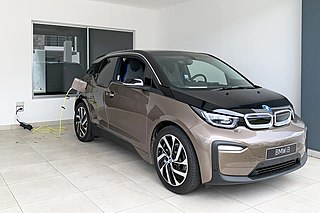
An electric vehicle (EV) is a vehicle whose propulsion is powered fully or mostly by electricity. EVs include road and rail vehicles, electric boats and underwater vessels, electric aircraft and electric spacecraft.

Alternative fuels, also known as non-conventional and advanced fuels, are fuels derived from sources other than petroleum. Alternative fuels include gaseous fossil fuels like propane, natural gas, methane, and ammonia; biofuels like biodiesel, bioalcohol, and refuse-derived fuel; and other renewable fuels like hydrogen and electricity.
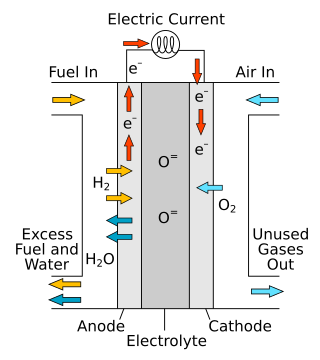
A solid oxide fuel cell is an electrochemical conversion device that produces electricity directly from oxidizing a fuel. Fuel cells are characterized by their electrolyte material; the SOFC has a solid oxide or ceramic electrolyte.

A fuel cell vehicle (FCV) or fuel cell electric vehicle (FCEV) is an electric vehicle that uses a fuel cell, sometimes in combination with a small battery or supercapacitor, to power its onboard electric motor. Fuel cells in vehicles generate electricity generally using oxygen from the air and compressed hydrogen. Most fuel cell vehicles are classified as zero-emissions vehicles. As compared with internal combustion vehicles, hydrogen vehicles centralize pollutants at the site of the hydrogen production, where hydrogen is typically derived from reformed natural gas. Transporting and storing hydrogen may also create pollutants. Fuel cells have been used in various kinds of vehicles including forklifts, especially in indoor applications where their clean emissions are important to air quality, and in space applications. Fuel cells are being developed and tested in trucks, buses, boats, ships, motorcycles and bicycles, among other kinds of vehicles.
Shore power or shore supply is the provision of shoreside electrical power to a ship at berth while its main and auxiliary engines are shut down. While the term denotes shore as opposed to off-shore, it is sometimes applied to aircraft or land-based vehicles, which may plug into grid power when parked for idle reduction.
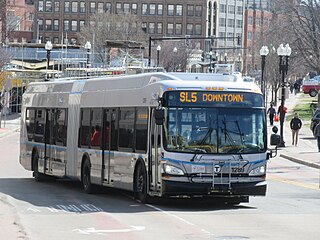
A hybrid electric vehicle (HEV) is a type of hybrid vehicle that couples a conventional internal combustion engine (ICE) with one or more electric engines into a combined propulsion system. The presence of the electric powertrain, which has inherently better energy conversion efficiency, is intended to achieve either better fuel economy or better acceleration performance than a conventional vehicle. There is a variety of HEV types and the degree to which each functions as an electric vehicle (EV) also varies. The most common form of HEV is hybrid electric passenger cars, although hybrid electric trucks, buses, motorboats, and aircraft also exist.

A refrigerator truck or chiller lorry, is a van or truck designed to carry perishable freight at low temperatures. Most long-distance refrigerated transport by truck is done in articulated trucks pulling refrigerated hardside (box) semi-trailers, although insulated curtainsiders are common in some countries. Occasionally, refrigerated trailers have been used as temporary morgues, and second-hand refrigerated trailers are frequently sold for use in tiny home conversions due to their insulation and existing status as a vehicle.
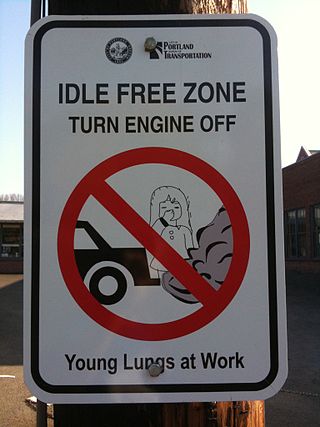
Idle reduction describes technologies and practices that minimize the amount of time drivers idle their engines. Avoiding idling time has a multitude of benefits including: savings in fuel and maintenance costs, extending vehicle life, and reducing damaging emissions. An idling engine consumes only enough power to keep itself and its accessories running, therefore, producing no usable power to the drive train.

Reformed Methanol Fuel Cell (RMFC) or Indirect Methanol Fuel Cell (IMFC) systems are a subcategory of proton-exchange fuel cells where, the fuel, methanol (CH3OH), is reformed, before being fed into the fuel cell.

Advanced steam technology reflects an approach to the technical development of the steam engine intended for a wider variety of applications than has recently been the case. Particular attention has been given to endemic problems that led to the demise of steam power in small- to medium-scale commercial applications: excessive pollution, maintenance costs, labour-intensive operation, low power/weight ratio, and low overall thermal efficiency; where steam power has generally now been superseded by the internal combustion engine or by electrical power drawn from an electrical grid. The only steam installations that are in widespread use are the highly efficient thermal power plants used for generating electricity on a large scale. In contrast, the proposed steam engines may be for stationary, road, rail or marine use.
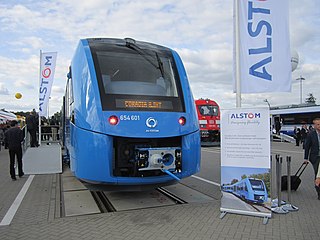
In transportation, the original (2003) generic term "hydrail" includes hydrogen trains, zero-emission multiple units, or ZEMUs — generic terms describing rail vehicles, large or small, which use on-board hydrogen fuel as a source of energy to power the traction motors, or the auxiliaries, or both. Hydrail vehicles use the chemical energy of hydrogen for propulsion, either by burning hydrogen in a hydrogen internal combustion engine, or by reacting hydrogen with oxygen in a fuel cell to run electric motors, as the hydrogen fuel cell train. Widespread use of hydrogen for fueling rail transportation is a basic element of the proposed hydrogen economy. The term has been used by research scholars and technicians around the world.

The Railpower GG20BGreen Goat is a low-emissions diesel hybrid switcher locomotive built by Railpower Technologies Corp. It is powered by a single Caterpillar C9 six cylinder inline engine developing 300 horsepower (224 kW), which is also connected to a large battery bank where both sources combine for a total power output of 2,000 horsepower (1,490 kW). To date, there have been more than 50 GG20B diesel-electric hybrid switchers manufactured since their first introduction in 2004.

A range extender is a fuel-based auxiliary power unit (APU) that extends the range of a battery electric vehicle by driving an electric generator that charges the vehicle's battery. This arrangement is known as a series hybrid drivetrain. The most commonly used range extenders are internal combustion engines, but fuel-cells or other engine types can be used.

Carbon Recycling International (CRI) is an Icelandic limited liability company which has developed a technology designed to produce renewable methanol, also known as e-methanol, from carbon dioxide and hydrogen, using water electrolysis or, alternatively, hydrogen captured from industrial waste gases. The technology is trademarked by CRI as Emissions-to-Liquids (ETL) and the renewable methanol produced by CRI is trademarked as Vulcanol. In 2011 CRI became the first company to produce and sell liquid renewable transport fuel produced using only carbon dioxide, water and electricity from renewable sources.
Power-to-gas is a technology that uses electric power to produce a gaseous fuel.

FuelCell Energy, Inc. is a publicly traded fuel cell company headquartered in Danbury, Connecticut. It designs, manufactures, operates and services Direct Fuel Cell power plants, which is a type of molten carbonate fuel cell.
References
- ↑ fuel cells for auxiliary power unit applications Archived 2013-12-03 at the Wayback Machine
- ↑ "Investment in fuel cells for auxiliary power unit applications to reach $400 million by 2020, according to Pike research". Archived from the original on 2013-12-03. Retrieved 2013-11-28.
- 1 2 Refrigerated trucks to keep their cool thanks to fuel cell technology
- ↑ Broderick, Christie-Joy; Timothy Lipman; Mohammad Farshchi; Nicholas Lutsey; Harry Dwyer; Daniel Sperling; William Gouse; Bruce Harris; Foy King (2002). "Evaluation of Fuel Cell auxiliary Power Units for Heavy-Duty Diesel Trucks" (PDF). Transportation Research Part D. Elsevier Sciences Ltd. pp. 303–315. Archived from the original (PDF) on 2012-04-03. Retrieved 2011-09-27.
- 1 2 Weissler, Paul (2010-05-12). "Delphi truck fuel-cell APU to hit road in 2012". Vehicle Electrification. Archived from the original on 2016-05-28. Retrieved 2011-09-27.
and Delphi says it will have a 5-kW APU on the market in 2012.
- ↑ Jacobs, Mike (2009-03-19). "Solid Oxide Fuel Cell Successfully Powers Truck Cab and Sleeper in DOE-Sponsored Test". NETL: News Release. National Energy Technology Laboratory. Archived from the original on 2012-02-02. Retrieved 2011-09-27.
- ↑ "XII.4 Solid Oxide Fuel Cell Diesel Auxiliary Power Unit Demonstration" (PDF).
- ↑ Fuel cell assisted APU system for diesel-electric locomotives
- ↑ PowerCell unveils 3kW PowerPac fuel cell APU that converts diesel into electricity